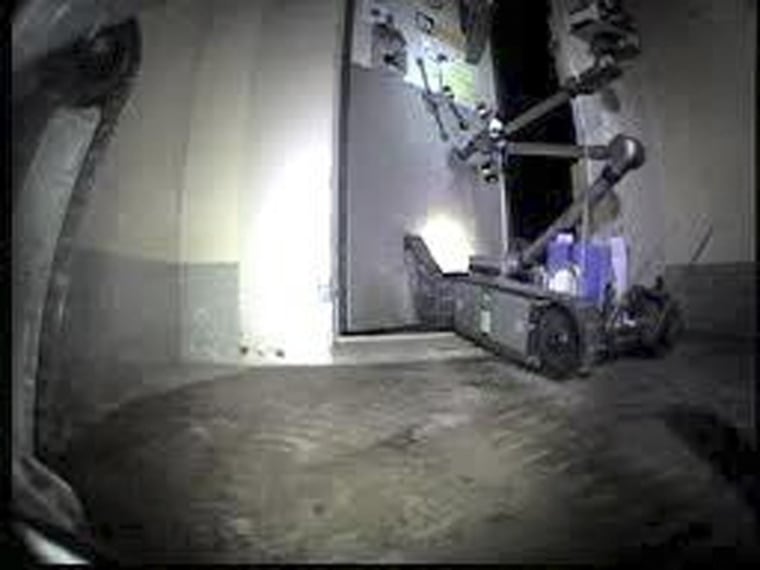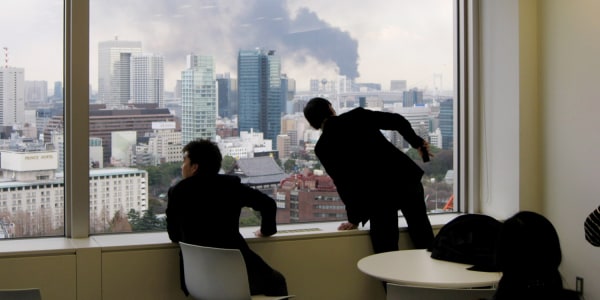A pair of thin robots on treads sent to explore buildings inside Japan's crippled nuclear reactor came back Monday with disheartening news: Radiation levels are far too high for repair crews to go inside.
Nevertheless, officials remained hopeful they can stick to their freshly minted "roadmap" for cleaning up the radiation leak and stabilizing the Fukushima Dai-ichi plant by year's end so they can begin returning tens of thousands of evacuees to their homes.
"Even I had expected high radioactivity in those areas. I'm sure (plant operator Tokyo Electric Power Co.) and other experts have factored in those figures when they compiled the roadmap," Chief Cabinet Secretary Yukio Edano said.
Officials said Monday that radiation had spiked in a water tank in Unit 2 and contaminated water was discovered in other areas of the plant. They also described in detail for the first time the damage to fuel in three troubled reactors, saying pellets had melted.
That damage — sometimes referred to as a partial meltdown — had already been widely assumed, but the confirmation, along with the continued release of radiation from other areas, serves to underscore how difficult and how long the cleanup process will be. In fact, government officials themselves have acknowledged that there are still many setbacks that could crop up to slow down their timeline.
Slideshow 46 photos
Triple tragedy for Japan
Most Japanese want a new prime minister to lead rebuilding after last month's earthquake and tsunami, newspaper polls showed on Monday. Nearly 70 percent of people surveyed by the Nikkei business daily said Prime Minister Naoto Kan should be replaced, and a similar number said the government's response to the nuclear crisis was not acceptable.
Kan was criticized again in parliament on Monday for his response to the nuclear disaster. An opposition lawmaker suggested he had been ill-prepared from the start, pointing to Kan's admission that he could not recall the details of a drill last year that simulated a Fukushima-type incident.
"Prime Minister Kan is working hard and he must be experiencing difficulties. But many people have questions about his leadership," opposition Liberal Democratic Party lawmaker Masashi Waki told the upper house budget committee.
Kan said he and his government were doing their best.
"Japan has experienced many crises in the past, but I believe this is the biggest crisis in the 65 years since the end of World War Two," he told a parliamentary panel on Monday.
"From now on ... we must persist with our strategy on two fronts, and I want to make every effort on both issues," he said, referring to rebuilding the country and resolving the nuclear crisis.
Workers have not been able to enter the reactor buildings at the stricken plant since the first days after the cooling systems were wrecked by the March 11 earthquake and tsunami that left more than 27,000 people dead or missing. Hydrogen explosions in both buildings in the first few days destroyed their roofs and scattered radioactive debris.
On Sunday, a plant worker opened an outer door to one of the buildings and two Packbots, which resemble drafting lamps on tank-like treads, entered. After the worker closed the door, one robot opened an inner door and both rolled inside to take readings for temperature, pressure and radioactivity. They later entered a second building.
The robots reported radioactivity readings of up to 49 millisieverts per hour inside Unit 1 and up to 57 inside Unit 3, levels too high for workers to realistically enter.
"It's a harsh environment for humans to work inside," said Hidehiko Nishiyama of Japan's Nuclear and Industrial Safety Agency.
Japanese authorities more than doubled the legal limit for nuclear workers since the crisis began to 250 millisieverts a year. Workers in the U.S. nuclear industry are allowed an upper limit of 50 millisieverts per year. Doctors say radiation sickness sets in at 1,000 millisieverts and includes nausea and vomiting.
The robots, made by Bedford, Massachusetts, company iRobot, which also makes the Roomba vacuum cleaner, explored Unit 2 on Monday, but TEPCO officials had yet to analyze that data.
The radioactivity must be reduced, possibly with the removal of contaminated debris and stagnant water, before repair crews would be allowed inside, said NISA official Masataka Yoshizawa.
Sturdier robots can remove some of the debris, but workers are needed to test the integrity of the equipment and carry out electrical repairs needed to restore the cooling systems as called for in the road map, Yoshizawa said.
"What robots can do is limited, so eventually, people must enter the buildings," TEPCO official Takeshi Makigami said.
The robots, along with remote-controlled miniature drones, have enabled TEPCO to photograph and take measurements of conditions in and around the plant while minimizing workers' exposure to radiation and other hazards.
Separately, readings from a water tank attached to the spent fuel pool in Unit 2 showed a severe spike in radiation that NISA officials said might have been caused by the escape of radioactive vapor from a nearby containment vessel. They said, however, the possibility of damage to spent fuel rods could not be ruled out.
Meanwhile, Toyota Motor Corp. resumed car production at all of its plants in Japan on Monday for the first time since the quake and tsunami, but said the factories will run at half capacity due to parts shortages.
The world's No. 1 automaker said it was still struggling to secure around 150 types of auto components. The magnitude-9.0 earthquake and ensuing tsunami destroyed parts factories in northeastern Japan, causing severe shortages.
The twin disasters forced Toyota to shut down all output in Japan except at three plants, which have been running at limited capacity since late March and early April to produce hot-selling Prius, Lexus and Corolla cars.
The 900 workers at Toyota's auto plant in Miyagi, one of the worst-hit areas in the disasters, observed a minute's silence for tsunami victims before starting work Monday.

